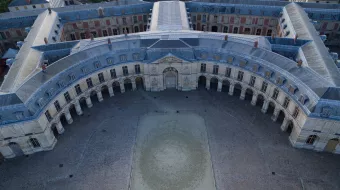OPENING
The Gallery of Coaches is open every weekends and French bank holidays (except 1 January and 25 December) from 12:30pm to 5:30pm (last entrance at 4:45pm).
Consult the detailed opening hours.
Duration
1 hour
Access
From the Château de Versailles, about 8 minutes on foot, on the town side. Locate the Gallery of Coaches
Ticket
Free access

In the heart of the great stables
Built by Hardouin-Mansart between 1679 and 1682, the buildings of the Great and Small Stables are identical, their names being based not on their size but on their role during the Ancien Régime. To the north, the Great Stables were under the authority of the Grand Equerry of France, known as "Monsieur le Grand", and housed the perfectly trained steeds for hunting and warfare. During the Ancien Régime carriages and fantastical vehicles, sleds and coaches were kept in the Small Stables managed by the First Equerry, known as "Monsieur le Premier", who was also in charge of carriage horses and mounts in everyday use.
The Gallery of Coaches is on the ground floor of the Great Stables. It consists of two vaulted galleries which house an impressive display of collections over nearly 1000 m2.


Travelling thrones in the Gallery of Coaches
The collection of coaches in Versailles is not composed of travel vehicles but consists of grand ceremonial Berlin Coaches. Each carriage tells a piece of French history through a dynastic or political event such as the marriage of Napoléon I, the baptism of the Duke of Bordeaux, the coronation of Charles X or the funeral of Louis XVIII. Designed to impress, these coaches are true works of art. Ostentatiously luxurious and adorned with a profusion of gold decoration and carvings, they are a dazzling blend of all the decorative arts and were manufactured by the best artists and artisans at the time, including architects, cabinetmakers, sculptors, bronze workers, gilders, upholsterers and embroiderers. The King's Coach, designed to show off the sovereign, and the many coaches which followed it, travelled at walking pace (about 3 km/h). Today we can imagine the splendour of these great cavalcades in the midst of jubilant crowds, the corteges of some 40 so impressively-sized coaches covered with gold, the beauty of hundreds of plumed horses and the thunder of hooves on the cobblestones.

The visit to the Gallery of Coaches also includes a film retracing the history of horse-drawn carriages since the reign of Louis XIV. In addition to their artistic qualities, these coaches showcased the latest developments in French coachbuilding in terms of elegance, comfort and technique.
A unique collection brought together by Louis-Philippe
This collection is one of the greatest in Europe and was brought together by King Louis-Philippe in 1831, when he converted the Royal Palace into a museum dedicated "To all the Glories of France". With the liquidation of the Civil List of Charles X – the coaches belonged to the king and not to the crown – Louis-Philippe acquired ten ceremonial carriages of historical interest along with splendid harnesses adorned with gilded bronze. This was how the imperial and royal Berlin Coaches came to be in the Small Stables and, two years later, the funeral hearse for Louis XVIII. The king then asked architect Charles-Auguste Questel to create a building in Trianon to house the coaches. Thanks to contributions from the Royal Furniture Treasury and the Mobilier National, sedan chairs and fantastical sleighs joined the collections in 1851, when the first Trianon Museum of Carriages opened its doors to the public. In 1978 the collection was returned to the Great Stables and Questel's building was demolished. In 1997 the Versailles Museum of Coaches opened to the public, and in 2016 the museum was enlarged and redistributed over the two galleries in the Great Stables.
Bibliography
For further information, a dedicated guide book was published when the Gallery of the Coaches reopened:
La Galerie des Carrosses. Château de Versailles, Hélène Delalex, Paris, Artlys, 2016.
Locate the Coach Gallery on a map
digital resources
Audio tour
Find the audio tour dedicated to the Gallery of Coaches on the official app of the Palace of Versailles.
Download it for free.
Coach gallery's leaflet
The leaflet is free and available for free at the entrance of the Gallery.
Game booklet about the Coaches collection of Versailles
To help children better understand the collection, the Palace of Versailles has designed a discovery game in partnership with Paris Môme. The games booklet is available for free at the entrance of the Gallery.










